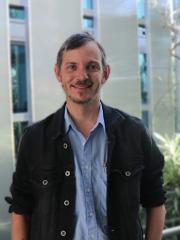Dr Dion Kent Weatherley

Dr Dion Weatherley is a computational rock mechanics specialist: rock fracture, fragmentation and flow dynamics.
Mining processes depend upon the material and mechanical properties of rocks. How a rock responds to mining-induced stresses, depends on the size of the rocks involved and the operational constraints. Dr Weatherley solves mathematical equations using supercomputers to physically model how the texture and composition of rock on different length scales contributes to its mechanical response: fracture, fragmentation and/or flow. Dion has applied his skills to investigate fragmentation and flow of rock masses in underground mines, as well as micro-mechanical studies on crack propagation within ore particles subjected to typical comminution or geotechnical loading. He is currently investigating mathematical techniques suitable for developing dynamic minerals process models.
Dion graduated with a Bachelor of Science in mathematical physics in 1997. He subsequently joined a collaborative effort to discover a physical basis for earthquake forecasting; enjoying mentorship from leading international scientists during his HDR studies. He was awarded an Australian Research Council Postdoctoral Fellowship to continue this research and later conjoined one of the first thematic computational research infrastructure projects, the Australian Computational Earth Systems Simulator Major National Research Facility (now part of AuScope Ltd). Dion remains one of the lead developers of ESyS-Particle, a supercomputer simulation package used by computational scientists spread across five continents and spanning numerous scientific disciplines.
Originally joining the SMI’s WH Bryan Mining Geology Research Centre (BRC) in 2008, Dion has applied his computational scientific skills to industrial problems including mass-movement in underground mines, surface erosion of rehabilitated land, long-term ecological monitoring of rehabilitated landscapes, and comminution of ore within minerals processing equipment. Dion’s cross-disciplinary talent is demonstrated by his research providing a mathematical basis for a controversial theory regarding the role of earthquakes during the formation of gold-bearing ore deposits (Weatherley and Henley, 2013). Dion currently leads strategic research aiming to deliver a precise, dynamic minerals process modelling platform, based on scientific knowledge obtained from laboratory, field and computational investigations.
Industry
Dion’s research on caving dynamics was funded by the Mass Mining Technologies Project, directed by SMI’s Prof Gideon Chitombo. He has also conducted research for individual companies on caving-related problems. His research on the micro-mechanics of rock fracture is a component of research strategically funded by The University of Queensland, to develop mechanistic comminution process models.
Collaborations
Dion has collaborated across disciplines throughout his career; including physicists, geologists, engineers of numerous persuasions, mathematicians, experimentalists and computational scientists. In many instances, Dion has adapted his numerical modelling skills to new application domains and contributed knowledge via computational scientific investigations. He also actively supports researchers to learn how to use his software as part of their own investigations.
Funding
Dion has been funded by Australian Research Council Fellowships and Projects, the National Collaborative Research Infrastructure Strategy, the Queensland Government, the Mass-Mining Technologies Project and The University of Queensland’s Vice-Chancellor’s Strategic Fund. He has attracted competitive research funding exceeding $3.5M and industrial projects totalling almost $2.5M.
